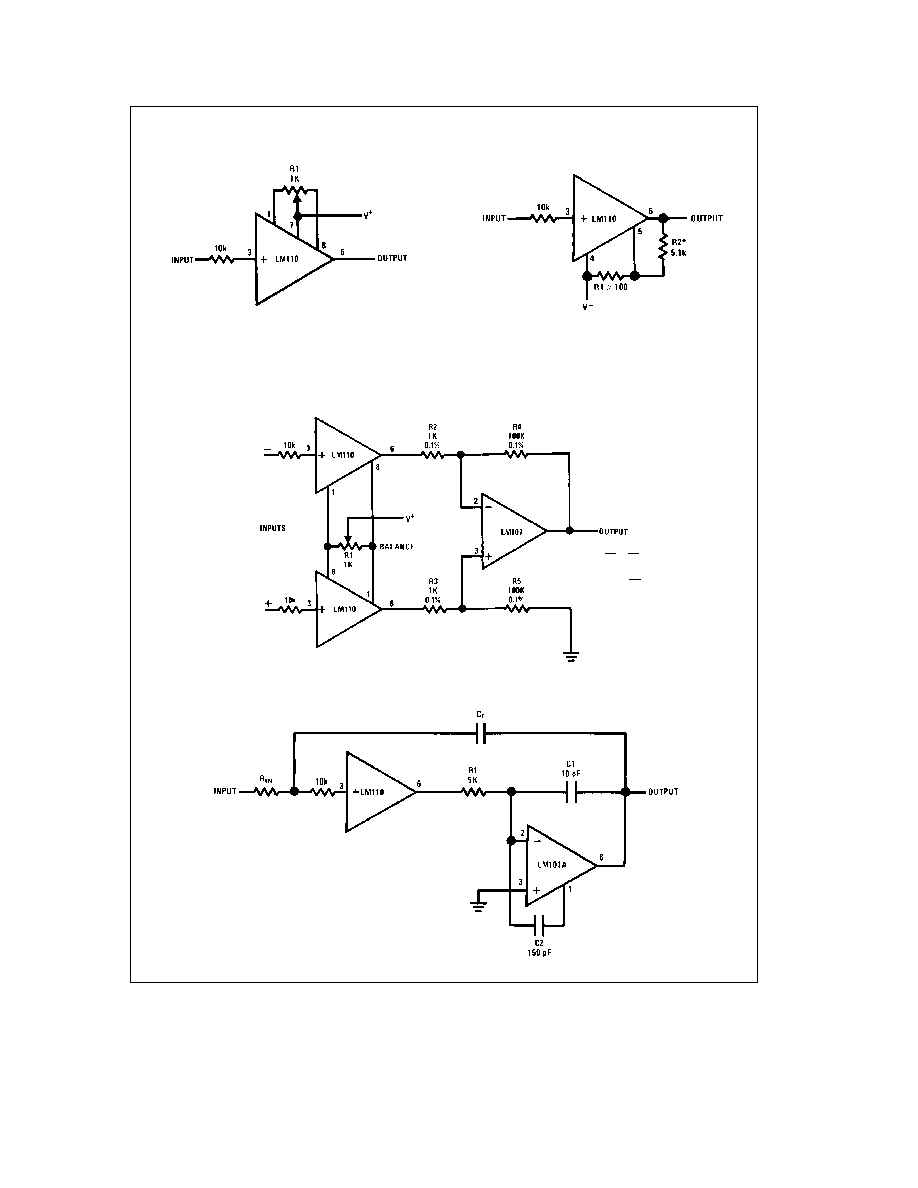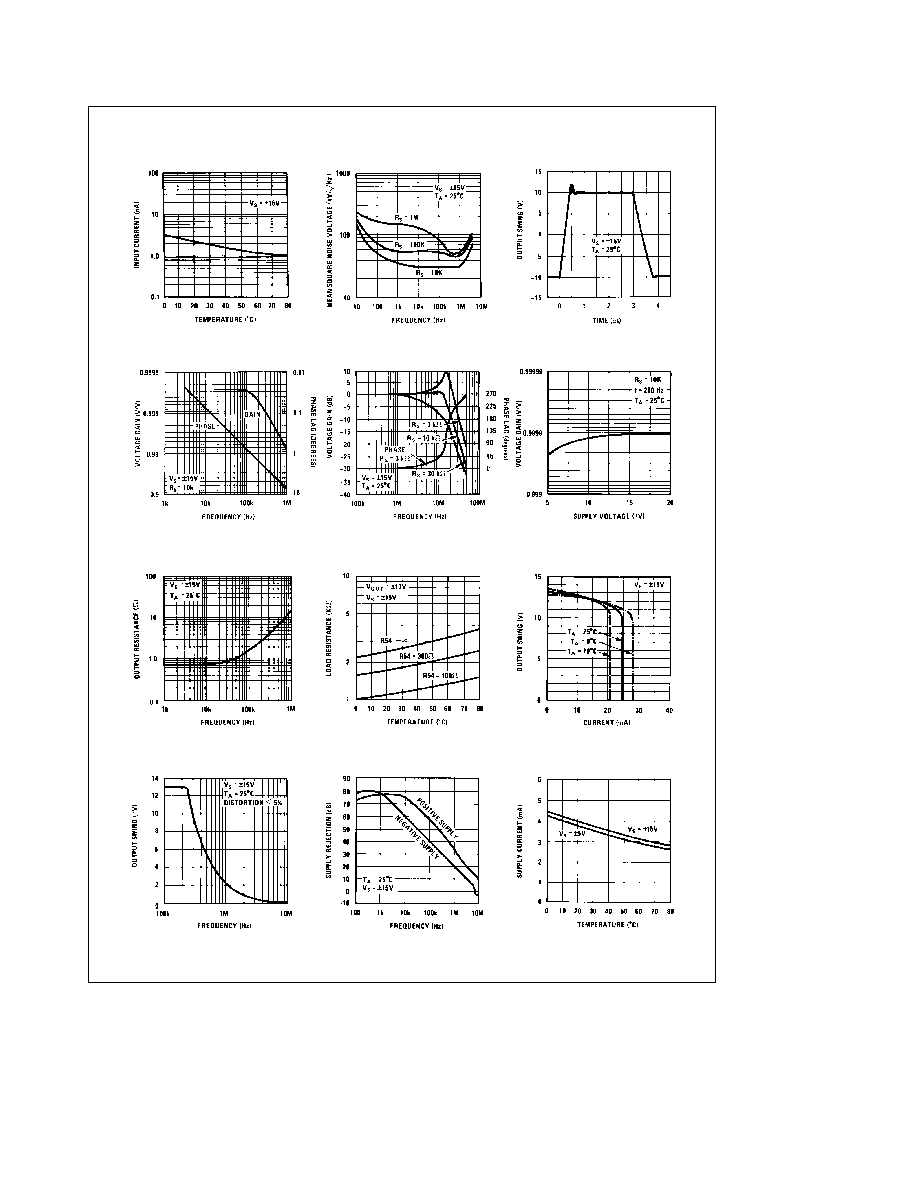
TL H 7761
LM110LM210LM310
Voltage
Follower
November 1994
LM110 LM210 LM310 Voltage Follower
General Description
The LM110 series are monolithic operational amplifiers in-
ternally connected as unity-gain non-inverting amplifiers
They use super-gain transistors in the input stage to get low
bias current without sacrificing speed Directly interchange-
able with 101 741 and 709 in voltage follower applications
these devices have internal frequency compensation and
provision for offset balancing
The LM110 series are useful in fast sample and hold cir-
cuits active filters or as general-purpose buffers Further
the frequency response is sufficiently better than standard
IC amplifiers that the followers can be included in the feed-
back loop without introducing instability They are plug-in
replacements for the LM102 series voltage followers offer-
ing lower offset voltage drift bias current and noise in addi-
tion to higher speed and wider operating voltage range
The LM110 is specified over a temperature range
b
55 C
s
T
A
s
a
125 C the LM210 from
b
25 C
s
T
A
s
a
85 C and
the LM310 from 0 C
s
T
A
s
a
70 C
Features
Y
Input current
10 nA max over temperature
Y
Small signal bandwidth
20 MHz
Y
Slew rate
30 V ms
Y
Supply voltage range
g
5V to
g
18V
Schematic Diagram
TL H 7761 ≠ 1
C1995 National Semiconductor Corporation
RRD-B30M115 Printed in U S A

Absolute Maximum Ratings
If Military Aerospace specified devices are required
please contact the National Semiconductor Sales
Office Distributors for availability and specifications
(Note 6)
Supply Voltage
g
18V
Power Dissipation (Note 1)
500 mW
Input Voltage (Note 2)
g
15V
Output Short Circuit Duration (Note 3)
Indefinite
Operating Temperature Range
LM110
b
55 C to
a
125 C
LM210
b
25 C to
a
85 C
LM310
0 C to
a
70 C
Storage Temperature Range
b
65 C to
a
150 C
Lead Temperature (Soldering 10 sec )
260 C
Soldering Information
Dual-In-Line Package
Soldering (10 sec )
260 C
Small Outline Package
Vapor Phase (60 sec )
215 C
Infrared (15 sec )
220 C
See AN-450 ``Surface Mounting Methods and Their Effect
on Product Reliability'' for other methods of soldering sur-
face mount devices
ESD rating to be determined
Electrical Characteristics
(Note 4)
Parameter
Conditions
LM110
LM210
LM310
Units
Min
Typ
Max
Min
Typ
Max
Min
Typ
Max
Input Offset Voltage
T
A
e
25 C
1 5
4 0
1 5
4 0
2 5
7 5
mV
Input Bias Current
T
A
e
25 C
1 0
3 0
1 0
3 0
2 0
7 0
nA
Input Resistance
T
A
e
25 C
10
10
10
12
10
10
10
12
10
10
10
12
X
Input Capacitance
1 5
1 5
1 5
pF
Large Signal Voltage
T
A
e
25 C V
S
e
g
15V
0 999
0 9999
0 999
0 9999
0 999
0 9999
V V
Gain
V
OUT
e
g
10V R
L
e
8 kX
Output Resistance
T
A
e
25 C
0 75
2 5
0 75
2 5
0 75
2 5
X
Supply Current
T
A
e
25 C
3 9
5 5
3 9
5 5
3 9
5 5
mA
Input Offset Voltage
6 0
6 0
10
mV
Offset Voltage
b
55 C
s
T
A
s
a
85 C
6
6
m
V C
Temperature Drift
a
85
s
T
A
s
125 C
12
m
V C
0 C
s
T
A
s
a
70 C
10
m
V C
Input Bias Current
10
10
10
nA
Large Signal Voltage
V
S
e
g
15V V
OUT
e
g
10V
0 999
0 999
0 999
V V
Gain
R
L
e
10 kX
Output Voltage
V
S
e
g
15V R
L
e
10 kX
g
10
g
10
g
10
V
Swing (Note 5)
Supply Current
T
A
e
125 C
2 0
4 0
2 0
4 0
mA
Supply Voltage
g
5V
s
V
S
s g
18V
70
80
70
80
70
80
dB
Rejection Ratio
Note 1
The maximum junction temperature of the LM110 is 150 C of the LM210 is 100 C and of the LM310 is 85 C For operating at elevated temperatures
devices in the HO8 package must be derated based on a thermal resistance of 165 C W junction to ambient or 22 C W junction to case The thermal resistance
of the dual-in-line package is 100 C W junction to ambient
Note 2
For supply voltages less than
g
15V the absolute maximum input voltage is equal to the supply voltage
Note 3
Continuous short circuit for the LM110 and LM210 is allowed for case temperatures to 125 C and ambient temperatures to 70 C and for the LM310 70 C
case temperature or 55 C ambient temperature It is necessary to insert a resistor greater than 2 kX in series with the input when the amplifier is driven from low
impedance sources to prevent damage when the output is shorted R
S
e
5k min 10k typical is recommended for dynamic stability in all applications
Note 4
These specifications apply for
g
5V
s
V
S
s g
18V and
b
55 C
s
T
A
125 C for the LM110
b
25 C
s
T
A
s
85 C for the LM210 and 0 C
s
T
A
s
70 C for
the LM310 unless otherwise specified
Note 5
Increased output swing under load can be obtained by connecting an external resistor between the booster and V
b
terminals See curve
Note 6
Refer to RETS110X for LM110H LM110J military specifications
Application Hint
The input must be driven from a source impedance of typically 10 kX (5 kX min ) to maintain stability The total source
impedance will be reduced at high frequencies if there is stray capacitance at the input pin In these cases a 10 kX resistor
should be inserted in series with the input physically close to the input pin to minimize the stray capacitance and prevent
oscillation
2

Auxiliary Circuits
Offset Balancing Circuit
TL H 7761 ≠ 2
Increasing Negative Swing Under Load
TL H 7761 ≠ 3
May be added to reduce internal dissipation
Typical Applications
Differential Input Instrumentation Amplifier
TL H 7761 ≠ 4
R4
R2
e
R5
R3
A
V
e
R4
R2
Fast Integrator with Low Input Current
TL H 7761 ≠ 5
5




